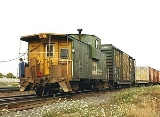
Caboose
Encyclopedia
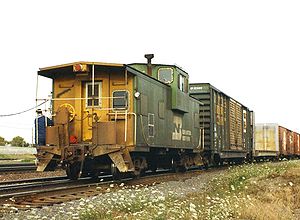
Railroad car
A railroad car or railway vehicle , also known as a bogie in Indian English, is a vehicle on a rail transport system that is used for the carrying of cargo or passengers. Cars can be coupled together into a train and hauled by one or more locomotives...
coupled at the end of a freight train
Freight train
A freight train or goods train is a group of freight cars or goods wagons hauled by one or more locomotives on a railway, ultimately transporting cargo between two points as part of the logistics chain...
. Although cabooses were once used on nearly every freight train, their use has declined and they are seldom seen on trains, except on locals and smaller railroads.
Function
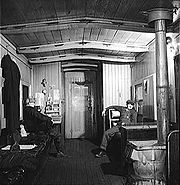
Hot box
A hot box is the term used when an axle bearing overheats on a piece of railway rolling stock. The term is derived from the journal-bearing trucks used before the mid 20th century. The axle bearings were housed in a box that used oil-soaked rags or cotton to reduce the friction of the axle...
es. The conductor kept records and handled business from a table or desk in the caboose. For longer trips the caboose provided minimal living quarters, and was frequently personalized and decorated with pictures and posters.
Coal or wood was originally used to fire a cast iron stove for heat and cooking, later giving way to a kerosene heater. Now rare, the old stoves can be identified by several essential features. They were without legs, bolted directly to the floor, and featured a lip on the top surface to keep pans and coffee pots from sliding off. They also had a double-latching door, to prevent accidental discharge of hot coals caused by the rocking motion of the caboose.
History
Early cabooses were nothing more than flat cars with small cabins erected on them, or modified box cars. The standard form of the American caboose had a platform at either end with curved grab rails to facilitate train crew members' ascent onto a moving train. A caboose was fitted with red lights called markers to enable the rear of the train to be seen at night. This has led to the phrase bringing up the markers to describe the last car on a train (these lights were officially what made a train a "train").Originally lit with oil lamp
Kerosene lamp
The kerosene lamp is a type of lighting device that uses kerosene as a fuel. This article refers to kerosene lamps that have a wick and a tall glass chimney. Kerosene lanterns that have a wick and a glass globe are related to kerosene lamps and are included here as well...
s, with the advent of electricity, later caboose versions incorporated an electrical generator
Electrical generator
In electricity generation, an electric generator is a device that converts mechanical energy to electrical energy. A generator forces electric charge to flow through an external electrical circuit. It is analogous to a water pump, which causes water to flow...
driven by belts coupled to one of the axles, which charged a lead-acid storage battery when the train was in motion.
Cabooses are non-revenue equipment and were often improvised or retained well beyond the normal lifetime of a freight car. Tradition on many lines held that the caboose should be painted a bright red, though on many lines it eventually became the practice to paint them in the same corporate colors as locomotives. The Kansas City Southern Railway
Kansas City Southern Railway
The Kansas City Southern Railway , owned by Kansas City Southern Industries, is the smallest and second-oldest Class I railroad company still in operation. KCS was founded in 1887 and is currently operating in a region consisting of ten central U.S. states...
were unique in that they bought cabooses with a stainless steel
Stainless steel
In metallurgy, stainless steel, also known as inox steel or inox from French "inoxydable", is defined as a steel alloy with a minimum of 10.5 or 11% chromium content by mass....
car body, and so were not obliged to paint them.
Brake or guard's vans (UK & Australia)
In the UK the brake van performed a function similar to the caboose on North American railroads, being the accommodation for the train crew at the rear of the train, specifically the train guard, hence its alternative name.In Great Britain
Great Britain
Great Britain or Britain is an island situated to the northwest of Continental Europe. It is the ninth largest island in the world, and the largest European island, as well as the largest of the British Isles...
, freight trains without a continuous train braking system in either the whole train or the rearmost section of the train (unfitted or partly fitted in UK railway parlance) were still prevalent until the early 1980s. On these trains, the brake van had two additional functions: the guard would use the brake van's brakes to assist with keeping the train under control on downwards gradients and whenever he could see that the locomotive's crew was attempting to slow the train; second, the brakes were left set on at a low setting all the time to ensure that the loose chain couplings often used between unfitted cars were kept taut, to minimise the risk of snapped coupling chains from the locomotive "snatching" or jerking, which was particularly problematic in the days of steam locomotives. Brake vans thus had a significant amount of ballast weight built into their structure to increase the available braking effort.
In 1968 the requirement for fully fitted freight trains to end with a guards van was lifted and the guard would ride in the rearmost locomotive cab, which, since the UK mostly uses double-ended locomotives, has a good view of the train. These days brake vans are only used in certain special cases, for example in trains with unusual cargoes or track maintenance trains, and are consequently very rare.
In Australia, brake vans (or guard's vans - both terms were in common use) were often also used for carrying parcels and light freight and usually had large compartments and loading doors for such items. Some of the larger vans also included a compartment for passengers travelling on goods services or drovers travelling with their livestock.
Crew cars
On long distance transcontinental trains travelling mainly through desert areas, crew cars have been instituted which are marshalled immediately behind the locomotives. These crew cars have accommodation for spare crew, cooking, sleeping and relaxation facilities. They are rebuilt from surplus passenger cars and rail motors.FRED and the decline of cabooses
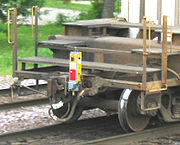
United States
The United States of America is a federal constitutional republic comprising fifty states and a federal district...
and Canada
Canada
Canada is a North American country consisting of ten provinces and three territories. Located in the northern part of the continent, it extends from the Atlantic Ocean in the east to the Pacific Ocean in the west, and northward into the Arctic Ocean...
required that all freight trains have a caboose and a full crew, for safety. Technology eventually advanced such that the railroads, in an effort to save money and reduce crew members, stated that a caboose was unnecessary, since there were improved bearings and lineside detectors
Defect detector
A defect detector is a device used on railroads to detect axle and signal problems in passing trains. The detectors are normally integrated into the tracks and often include sensors to detect several different kinds of problems that could occur...
to detect hot box
Hot box
A hot box is the term used when an axle bearing overheats on a piece of railway rolling stock. The term is derived from the journal-bearing trucks used before the mid 20th century. The axle bearings were housed in a box that used oil-soaked rags or cotton to reduce the friction of the axle...
es, and better designed cars to avoid problems with the load. The railroads also claimed that a caboose was also a dangerous place, as slack run-ins could hurl the crew from their places and even dislodge weighty equipment. With the introduction of FREDs (flashing rear-end device
Flashing rear-end device
The flashing rear-end device, or "FRED," is an electronic device mounted on the end of freight trains in lieu of a caboose...
/end-of-train device; often referred to by railroad companies as an EOTD, an acronym for "end of train device"), the caboose was no longer necessary.
A FRED could be attached to the rear of the train to detect the train's air brake pressure and report any problems back to the locomotive. The FRED also detects movement of the train upon start-up and radios this information to the engineer so they know that all of the slack is out of the couplings and additional power can now be applied. The machines also have a blinking red light to warn following trains that a train is ahead. With the introduction of the FRED, the conductor moved up to the front of the train with the engineer and year by year, cabooses started to fade away. Very few cabooses remain in operation today, though they are still used for some local trains where it is convenient to have a brakeman at the end of the train to operate switches.
Caboose types
The form of cabooses varied over the years, with changes made both to reflect differences in service and improvements in design. The most commonly seen types are as follows:
Cupola or "standard" caboose
The most common caboose form in AmericanUnited States
The United States of America is a federal constitutional republic comprising fifty states and a federal district...
railroad practice has a small windowed projection on the roof, called the cupola
Cupola
In architecture, a cupola is a small, most-often dome-like, structure on top of a building. Often used to provide a lookout or to admit light and air, it usually crowns a larger roof or dome....
. The crew sat in elevated seats in order to inspect the train from this perch.
The invention of the cupola caboose is generally attributed to T. B. Watson, a freight conductor
Conductor (transportation)
A conductor is a member of a railway train's crew that is responsible for operational and safety duties that do not involve the actual operation of the train. The title of conductor is most associated with railway operations in North America, but the role of conductor is common to railways...
on the Chicago and North Western Railway
Chicago and North Western Railway
The Chicago and North Western Transportation Company was a Class I railroad in the Midwest United States. It was also known as the North Western. The railroad operated more than of track as of the turn of the 20th century, and over of track in seven states before retrenchment in the late 1970s...
. In 1898 he wrote:
The position of the cupola varied. In most eastern railroad cabooses the cupola was in the center of the car, but most western railroads preferred to put it toward the end of the car. Some conductors preferred to have the cupola toward the front, others liked it toward the rear of the train, and some just didn't care. ATSF conductors could refuse to be assigned to a train if they didn't have their caboose turned to face the way they preferred. However this would be a rare union agreement clause that could be used but not a regular issue.
The classic idea of the 'little red caboose' at the end of every train came about when cabooses were painted a reddish-brown; however some railroads (UP, and NKP for example) painted their cabooses yellow or red & white. The most notable was the Santa Fe
Atchison, Topeka and Santa Fe Railway
The Atchison, Topeka and Santa Fe Railway , often abbreviated as Santa Fe, was one of the larger railroads in the United States. The company was first chartered in February 1859...
which in the 1970s started a rebuild program for their cabooses in which the cars were painted bright red with an 8-foot-diameter Santa Fe cross herald emblazoned on each side in yellow.
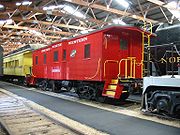
Bay window caboose
In a bay window caboose, the crew monitoring the train sits in the middle of the car in a section of wall that projects from the side of the caboose. The windows set into these extended walls resemble architectural bay windowBay window
A bay window is a window space projecting outward from the main walls of a building and forming a bay in a room, either square or polygonal in plan. The angles most commonly used on the inside corners of the bay are 90, 135 and 150 degrees. Bay windows are often associated with Victorian architecture...
s, so the caboose type is called a bay window caboose. This type afforded a better view of the side of the train and eliminated the falling hazard of the cupola. It is thought to have first been used on the Akron, Canton and Youngstown Railroad
Akron, Canton and Youngstown Railroad
The Akron, Canton and Youngstown Railroad was a railroad that existed between 1907 and 1982, running from Mogadore west to Delphos, Ohio, United States. It began as the Akron, Canton and Youngstown Railway, a short line connecting Mogadore to Akron...
in 1923, but is particularly associated with the Baltimore and Ohio Railroad
Baltimore and Ohio Railroad
The Baltimore and Ohio Railroad was one of the oldest railroads in the United States and the first common carrier railroad. It came into being mostly because the city of Baltimore wanted to compete with the newly constructed Erie Canal and another canal being proposed by Pennsylvania, which...
, which built all of its cabooses in this design starting from an experimental model in 1930. The bay window gained favor with many railroads also because it eliminated the need for additional clearances in tunnels and overpasses.
On the West Coast, the Milwaukee Road
Chicago, Milwaukee, St. Paul and Pacific Railroad
The Milwaukee Road, officially the Chicago, Milwaukee, St. Paul and Pacific Railroad , was a Class I railroad that operated in the Midwest and Northwest of the United States from 1847 until its merger into the Soo Line Railroad on January 1, 1986. The company went through several official names...
and the Northern Pacific Railway
Northern Pacific Railway
The Northern Pacific Railway was a railway that operated in the west along the Canadian border of the United States. Construction began in 1870 and the main line opened all the way from the Great Lakes to the Pacific when former president Ulysses S. Grant drove in the final "golden spike" in...
used these cars converting over 900 roof top cabooses to bay windows in the late 1930s. Milwaukee Road rib side bay window cabooses are preserved at New Lisbon, Wisconsin
New Lisbon, Wisconsin
New Lisbon is a city in Juneau County, Wisconsin, United States. The population was 1,436 at the 2000 census.-Geography:New Lisbon is located at ....
, the Illinois Railway Museum
Illinois Railway Museum
The Illinois Railway Museum is the largest railroad museum in the United States and is located in Union, Illinois, northwest of Chicago...
, the Mt. Rainier Scenic Railroad
Mt. Rainier Scenic Railroad
The Mt. Rainier Scenic Railroad is a steam-powered heritage railroad operating in Washington State between Elbe and Mineral. The railroad travels on tracks that pass through thick forest just south of Mount Rainier. The depot, gift shop and ticket office are located in Elbe...
and Cedarburg, Wisconsin
Cedarburg, Wisconsin
Cedarburg is a city in Ozaukee County, Wisconsin, United States with Cedar Creek running through it. The city is bordered by the Village of Grafton to the east and the Town of Cedarburg elsewhere...
, among other places.
The Western Pacific Railroad
Western Pacific Railroad
The Western Pacific Railroad was a Class I railroad in the United States. It was formed in 1903 as an attempt to break the near-monopoly the Southern Pacific Railroad had on rail service into northern California...
was an early adopter of the type, building their own bay window cars starting in 1942 and acquiring this style exclusively from then on. Many other roads operated this type, including the Southern Pacific Railroad
Southern Pacific Railroad
The Southern Pacific Transportation Company , earlier Southern Pacific Railroad and Southern Pacific Company, and usually simply called the Southern Pacific or Espee, was an American railroad....
, St. Louis – San Francisco Railway, Kansas City Southern, the Southern Railway
Southern Railway (US)
The Southern Railway is a former United States railroad. It was the product of nearly 150 predecessor lines that were combined, reorganized and recombined beginning in the 1830s, formally becoming the Southern Railway in 1894...
, and the New York Central Railroad
New York Central Railroad
The New York Central Railroad , known simply as the New York Central in its publicity, was a railroad operating in the Northeastern United States...
.
In the UK, brake vans are usually of this basic design: the bay window is known as a lookout or ducket.
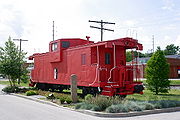
Extended vision caboose
In the "Extended Vision" or "Wide Vision" caboose, the sides of the cupola project beyond the side of the carbody. Rock IslandChicago, Rock Island and Pacific Railroad
The Chicago, Rock Island and Pacific Railroad was a Class I railroad in the United States. It was also known as the Rock Island Line, or, in its final years, The Rock.-Incorporation:...
created some of these by rebuilding some standard cupola cabooses with windowed extensions applied to the sides of the cupola itself, but by far the greatest number have the entire cupola compartment enlarged. This model was introduced by the International Car Company and saw service on most U.S. railroads. The expanded cupola allowed the crew to see past the top of the taller cars that began to appear after World War II
World War II
World War II, or the Second World War , was a global conflict lasting from 1939 to 1945, involving most of the world's nations—including all of the great powers—eventually forming two opposing military alliances: the Allies and the Axis...
, and also increased the roominess of the cupola area.
Additionally, Monon Railroad
Monon Railroad
The Monon Railroad , also known as the Chicago, Indianapolis and Louisville Railway from 1897–1956, operated almost entirely within the state of Indiana...
had a unique change to the extended vision cabooses. They added a miniature bay to the sides of the cupola to enhance the views further. This created a unique look for their small fleet. Seven of the eight Monon-built cabooses have been saved. One was scrapped after an accident in Kentucky. The surviving cars are at the Indiana Transportation Museum
Indiana Transportation Museum
The Indiana Transportation Museum is a railroad museum located in the Forest Park neighborhood of Noblesville, Indiana...
(operational), the Indiana Railroad Museum (operational), the Kentucky Railway Museum
Kentucky Railway Museum
The Kentucky Railway Museum, located in New Haven, Kentucky, United States, is a non-profit railroad museum dedicated to educating the public regarding the history and heritage of Kentucky's railroads and the people who built them. Originally created in 1954 in Louisville, Kentucky, the museum is...
(fire damaged), and the Bluegrass Railroad Museum (unrestored but servicable). The remaining three are in private collections.
Transfer caboose

Rail yard
A rail yard, or railroad yard, is a complex series of railroad tracks for storing, sorting, or loading/unloading, railroad cars and/or locomotives. Railroad yards have many tracks in parallel for keeping rolling stock stored off the mainline, so that they do not obstruct the flow of traffic....
s or short switching runs, and as such lacks sleeping, cooking or restroom facilities. The ends of a transfer caboose are left open, with safety railings surrounding the area between the crew compartment and the end of the car.
A recent variation on the transfer caboose is the "pushing" or "shoving" platform. It can be any railcar where a brakeman
Brakeman
A brakeman is a rail transport worker whose original job it was to assist the braking of a train by applying brakes on individual wagons. The advent of through brakes on trains made this role redundant, although the name lives on in the United States where brakemen carry out a variety of functions...
can safely ride for some distance to help the engineer with visibility at the other end of the train. Flatcar
Flatcar
A flatcar is a piece of railroad or railway rolling stock that consists of an open, flat deck on four or six wheels or a pair of trucks or bogies . The deck of the car can be wood or steel, and the sides of the deck can include pockets for stakes or tie-down points to secure loads...
s and covered hopper
Covered hopper
A Covered Hopper is a railroad freight car. They are designed for carrying dry bulk loads, varying from grain to products such as sand and clay. The cover protects the loads from the weather - dried cement would be very hard to unload if mixed with water in transit, while grain would be liable to...
s have been used for this purpose, but often the pushing platform is a caboose that has had its windows covered and welded shut and permanently locked doors. CSX
CSX Transportation
CSX Transportation operates a Class I railroad in the United States known as the CSX Railroad. It is the main subsidiary of the CSX Corporation. The company is headquartered in Jacksonville, Florida, and owns approximately 21,000 route miles...
uses former Missouri Pacific Railroad
Missouri Pacific Railroad
The Missouri Pacific Railroad , also known as the MoPac, was one of the first railroads in the United States west of the Mississippi River. MoPac was a Class I railroad growing from dozens of predecessors and mergers, including the St. Louis, Iron Mountain and Southern Railway , Texas and Pacific...
"shorty" transfer cabooses and marks them as pushing platforms.
Drover's caboose
Drover's cabooses looked more like combine carCombine car
A combine car in North American parlance, most often referred to simply as a combine, is a type of railroad car which combines sections for both passengers and freight....
s than standard cabooses. The purpose of a drover's caboose was much more like a combine as well. On longer livestock
Livestock
Livestock refers to one or more domesticated animals raised in an agricultural setting to produce commodities such as food, fiber and labor. The term "livestock" as used in this article does not include poultry or farmed fish; however the inclusion of these, especially poultry, within the meaning...
trains in the American west, the drover's caboose is where the livestock's handlers would ride between the ranch
Ranch
A ranch is an area of landscape, including various structures, given primarily to the practice of ranching, the practice of raising grazing livestock such as cattle or sheep for meat or wool. The word most often applies to livestock-raising operations in the western United States and Canada, though...
and processing plant. The train crew rode in the caboose section while the livestock handlers rode in the coach section. Drover's cabooses used either cupolas or bay windows in the caboose section for the train crew to monitor the train. The use of drover's cars on the Northern Pacific Railway
Northern Pacific Railway
The Northern Pacific Railway was a railway that operated in the west along the Canadian border of the United States. Construction began in 1870 and the main line opened all the way from the Great Lakes to the Pacific when former president Ulysses S. Grant drove in the final "golden spike" in...
, for example, lasted until the Burlington Northern Railroad
Burlington Northern Railroad
The Burlington Northern Railroad was a United States-based railroad company formed from a merger of four major U.S. railroads. Burlington Northern operated between 1970 and 1996....
merger of 1970. They were often found on stock trains originating in Montana
Montana
Montana is a state in the Western United States. The western third of Montana contains numerous mountain ranges. Smaller, "island ranges" are found in the central third of the state, for a total of 77 named ranges of the Rocky Mountains. This geographical fact is reflected in the state's name,...
.
Etymology
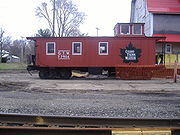
The railroad historian David L. Joslyn (a retired Southern Pacific Railroad
Southern Pacific Railroad
The Southern Pacific Transportation Company , earlier Southern Pacific Railroad and Southern Pacific Company, and usually simply called the Southern Pacific or Espee, was an American railroad....
draftsman) has connected caboose to kabhuis, a Middle Dutch
Middle Dutch
Middle Dutch is a collective name for a number of closely related West Germanic dialects which were spoken and written between 1150 and 1500...
word referring to the compartment on a sailing ship
Sailing ship
The term sailing ship is now used to refer to any large wind-powered vessel. In technical terms, a ship was a sailing vessel with a specific rig of at least three masts, square rigged on all of them, making the sailing adjective redundant. In popular usage "ship" became associated with all large...
's main deck
Deck (ship)
A deck is a permanent covering over a compartment or a hull of a ship. On a boat or ship, the primary deck is the horizontal structure which forms the 'roof' for the hull, which both strengthens the hull and serves as the primary working surface...
in which meals were prepared. Kabhuis is believed to have entered the Dutch language
Dutch language
Dutch is a West Germanic language and the native language of the majority of the population of the Netherlands, Belgium, and Suriname, the three member states of the Dutch Language Union. Most speakers live in the European Union, where it is a first language for about 23 million and a second...
circa 1747 as a derivation of the obsolete Low German
Low German
Low German or Low Saxon is an Ingvaeonic West Germanic language spoken mainly in northern Germany and the eastern part of the Netherlands...
word kabhuse, which also described a cabin erected on a ship
Ship
Since the end of the age of sail a ship has been any large buoyant marine vessel. Ships are generally distinguished from boats based on size and cargo or passenger capacity. Ships are used on lakes, seas, and rivers for a variety of activities, such as the transport of people or goods, fishing,...
's main deck. However, further research indicates that this relationship was more indirect than that described by Joslyn.
Eighteenth century French
France
The French Republic , The French Republic , The French Republic , (commonly known as France , is a unitary semi-presidential republic in Western Europe with several overseas territories and islands located on other continents and in the Indian, Pacific, and Atlantic oceans. Metropolitan France...
naval records make reference to a cambose or camboose, which term described the food preparation cabin on a ship's main deck, as well as the range
Stove
A stove is an enclosed heated space. The term is commonly taken to mean an enclosed space in which fuel is burned to provide heating, either to heat the space in which the stove is situated or to heat the stove itself, and items placed on it...
within. The latter sense apparently entered American
United States
The United States of America is a federal constitutional republic comprising fifty states and a federal district...
naval terminology around time of the construction of the USS Constitution
USS Constitution
USS Constitution is a wooden-hulled, three-masted heavy frigate of the United States Navy. Named by President George Washington after the Constitution of the United States of America, she is the world's oldest floating commissioned naval vessel...
, whose wood-burning food preparation stove is officially referred to as the camboose. These nautical usages are now obsolete: camboose and kabhuis became the galley
Galley (kitchen)
The galley is the compartment of a ship, train or aircraft where food is cooked and prepared. It can also refer to a land based kitchen on a naval base or a particular formed household kitchen.-Ship's kitchen:...
when meal preparation was moved below deck, camboose the stove became the galley range, and kabhuis the cookshack morphed into kombuis, which means kitchen
Kitchen
A kitchen is a room or part of a room used for cooking and food preparation.In the West, a modern residential kitchen is typically equipped with a stove, a sink with hot and cold running water, a refrigerator and kitchen cabinets arranged according to a modular design. Many households have a...
in Afrikaans
Afrikaans
Afrikaans is a West Germanic language, spoken natively in South Africa and Namibia. It is a daughter language of Dutch, originating in its 17th century dialects, collectively referred to as Cape Dutch .Afrikaans is a daughter language of Dutch; see , , , , , .Afrikaans was historically called Cape...
and Dutch.
It is likely that camboose was borrowed by American sailors who had come into contact with their French counterparts during the American Revolution
American Revolutionary War
The American Revolutionary War , the American War of Independence, or simply the Revolutionary War, began as a war between the Kingdom of Great Britain and thirteen British colonies in North America, and ended in a global war between several European great powers.The war was the result of the...
(recall that France was an ally and provided crucial naval support during the conflict). A New English Dictionary citation from the 1940s indicates that camboose entered English language literature in a New York Chronicle article from 1805 describing a New England
New England
New England is a region in the northeastern corner of the United States consisting of the six states of Maine, New Hampshire, Vermont, Massachusetts, Rhode Island, and Connecticut...
shipwreck
Shipwreck
A shipwreck is what remains of a ship that has wrecked, either sunk or beached. Whatever the cause, a sunken ship or a wrecked ship is a physical example of the event: this explains why the two concepts are often overlapping in English....
, in which it was reported that "[Survivor] William Duncan drifted aboard the canboose [sic]." From this it could be concluded that camboose was part of American English by the time the first railroads were constructed. As the first cabooses were wooden shanties erected on flat cars (as early as the 1830s) they would have resembled the cook shack on the (relatively flat) deck of a ship, explaining the adoption and subsequent corruption of the nautical term.
There is some disagreement on what constitutes the proper plural
Plural
In linguistics, plurality or [a] plural is a concept of quantity representing a value of more-than-one. Typically applied to nouns, a plural word or marker is used to distinguish a value other than the default quantity of a noun, which is typically one...
form of the word "caboose." Similar words, like goose
Goose
The word goose is the English name for a group of waterfowl, belonging to the family Anatidae. This family also includes swans, most of which are larger than true geese, and ducks, which are smaller....
(pluralized as "geese"), and moose
Moose
The moose or Eurasian elk is the largest extant species in the deer family. Moose are distinguished by the palmate antlers of the males; other members of the family have antlers with a dendritic configuration...
(pluralized as "moose," no change) point to the reason for the difficulty in coming to a consensus. The most common pluralization of caboose is "cabooses," with some arguing that this is incorrect, and, as with the word moose, it should stay the same in plural form—that is, "caboose" should represent one or many. A less-seriously used pluralization of the word is "cabeese," following the pluralization rule for the word goose
Goose
The word goose is the English name for a group of waterfowl, belonging to the family Anatidae. This family also includes swans, most of which are larger than true geese, and ducks, which are smaller....
, which is "geese." This particular form is almost universally used in an attempt at humor.
It was common for railroads to officially refer to cabooses as "cabin cars."
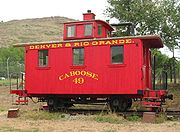
Slang terms
Of all the implements of railroading, none has had more nicknames than the caboose. Many are of AmericanUnited States
The United States of America is a federal constitutional republic comprising fifty states and a federal district...
or Canadian origin and seek to describe the vehicle or its occupants in derisive ways. Often heard amongst crews was "crummy" (as in a crummy place to live, not elegant, often too hot or too cold, and perhaps not especially clean), "clown wagon," "hack," "waycar," "dog house," "go cart," "glory wagon," "monkey wagon" (a term that indirectly insulted the principal functionary
Conductor (transportation)
A conductor is a member of a railway train's crew that is responsible for operational and safety duties that do not involve the actual operation of the train. The title of conductor is most associated with railway operations in North America, but the role of conductor is common to railways...
who rode therein, no doubt coined by an engineer), "brain box" (the conductor was supposedly the brains of the train, as opposed to the "hogger" or engineer, who was presumed to be pigheaded), "palace," "buggy" (Boston & Maine/Maine Central), "van" (Eastern and Central Canada, usage possibly derived from the UK term for the caboose), and "cabin", or a variation heard at least on the Southern Railway, "cab". There were others as well, some too profane to appear in print.
The small, two-axle cabooses that were widely used during the latter part of the nineteenth century were called "bobbers," which term described their riding characteristics on the relatively uneven track of the time. Bobbers tended to produce an unpleasant pitching motion that was usually not present in more modern, two truck models.
Preservation and reuse of cabooses
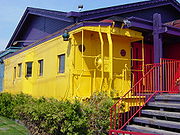
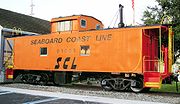
The Chihuahua al Pacífico
Chihuahua al Pacífico
The Ferrocarril Chihuahua al Pacífico , also known as El Chepe from its reporting mark CHP, or Ferrocarril Chihuahua-Pacífico is a major rail line in northwest Mexico, linking the city of Chihuahua, Chihuahua, to the city of Los Mochis, Sinaloa and its port Topolobampo...
Railroad in Mexico
Mexico
The United Mexican States , commonly known as Mexico , is a federal constitutional republic in North America. It is bordered on the north by the United States; on the south and west by the Pacific Ocean; on the southeast by Guatemala, Belize, and the Caribbean Sea; and on the east by the Gulf of...
still uses cabooses to accompany their motorail trains between Chihuahua
Chihuahua, Chihuahua
The city of Chihuahua is the state capital of the Mexican state of Chihuahua. It has a population of about 825,327. The predominant activity is industry, including domestic heavy, light industries, consumer goods production, and to a smaller extent maquiladoras.-History:It has been said that the...
and Los Mochis
Los Mochis
Los Mochis is a coastal city in northern Sinaloa, Mexico. It serves as the municipal seat of the municipality of Ahome. As of the 2010 census, the population was 256,613, which was 61 percent of the municipality's population....
.
Cabooses have also become popular for collection by railroad museums and for city parks and other civic uses, such as visitor centers. Several railroad museums roster large numbers of cabooses, including the Illinois Railway Museum
Illinois Railway Museum
The Illinois Railway Museum is the largest railroad museum in the United States and is located in Union, Illinois, northwest of Chicago...
with nineteen examples and the Western Pacific Railroad Museum
Western Pacific Railroad Museum
The Western Pacific Railroad Museum in Portola, California, formerly known as the Portola Railroad Museum before , is a heritage railroad that preserves and operates historic American railroad equipment. The museum's mission is to preserve the history of the Western Pacific Railroad and is...
at Portola, California
Portola, California
Portola is the only incorporated city in Plumas County, California, United States. The population was 2,104 at the 2010 census, down from 2,227 at the 2000 census...
, with seventeen. Many shortline railroads still use cabooses today. Large railroads also use cabooses as "shoving platforms" or in switching service where it is convenient to have crew at the rear of the train.
Cabooses have been re-used as vacation cottages, garden offices in private residences, and as portions of restaurants. Also, caboose motels have appeared, with the old cars being used as cabins.
In 1990, cabooses renovated in Gamecock colors and decor became part of the already famous University of South Carolina
University of South Carolina
The University of South Carolina is a public, co-educational research university located in Columbia, South Carolina, United States, with 7 surrounding satellite campuses. Its historic campus covers over in downtown Columbia not far from the South Carolina State House...
tailgate scene. They sit on a dormant railroad track just yards from Williams-Brice Stadium
Williams-Brice Stadium
Williams-Brice Stadium is the home football stadium for the South Carolina Gamecocks, the college football team representing the University of South Carolina in Columbia, South Carolina...
and have taken on a life of their own, in terms of parties on game days. The Cockaboose Railroad has contributed to Carolina's gameday atmosphere being named "Best in the SEC" twice by SECsports.com
External links
- The Red Caboose Motel a motel next to the Strasburg Railroad in Strasburg, PA where the guest rooms are retired cabooses
- The Featherbed Railroad Bed & Breakfast Resort a bed and breakfast on Clear Lake in Nice, CA where the guest rooms are retired cabooses
- The Caboose Station from the Potomac Eagle Scenic RailroadPotomac Eagle Scenic RailroadThe Potomac Eagle Scenic Railroad is a heritage railroad based in Romney, West Virginia.The railroad operates excursion trains over a former Baltimore and Ohio Railroad line that runs from Green Spring to Petersburg...
website: has information on introduction of the bay window caboose - "The Wood Shanty Disappears" from Southern Pacific Bulletin, January, 1962, pp 22–26
- "The Colorful Caboose" from Trains Magazine (undated article)
Multimedia
- CBC Radio Archives Talking about the end of the caboose in Canada (1989)

